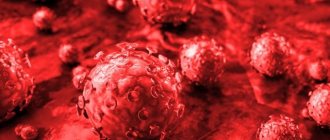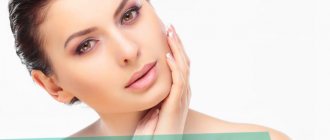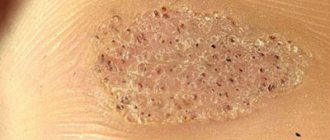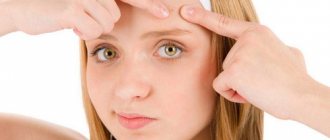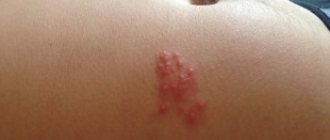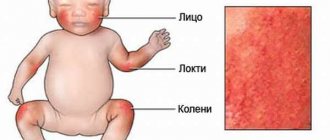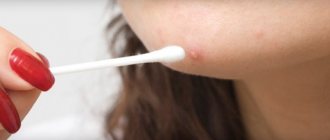Features of development
The mechanism for the development of irritation is based on clogged pores, which prevents the normal secretion of sweat. As a result, sweating decreases, the rate of evaporation drops significantly, and in response to this, skin irritation appears.
Sweat has a complex chemical composition. If something (in this case, clogged pores) prevents the normal secretion of sweat, the chemical elements in its composition begin to affect the skin. This leads to disruption of skin acidity and creates favorable conditions for the proliferation of pathogenic microflora. Thus, irritation develops precisely because of a large population of pathogenic microorganisms on the skin. This leads to the formation of a small vesicular or nodular rash, which is accompanied by unpleasant sensations.
Why does irritation occur?
Miliaria or sweat rashes on the body in adults are not uncommon. Skin irritation is caused by the following reasons:
- high air humidity at high temperatures;
- wearing synthetic fabrics;
- skin chafing and microtraumas;
- clogged pores due to the use of low-quality cosmetics;
- diseases associated with metabolic disorders;
- obesity.
In infancy, irritation appears due to the peculiarities of thermoregulation of the newborn’s body. Most often, such skin irritation occurs in the area where the diaper fits.
In adults, prickly heat is localized in places where the skin comes into contact with clothing, as well as in natural folds. Irritation “loves” the groin area, folds under the breasts in women, the inner side of the thigh, the bends of the elbow and knee, and the armpits.
Most often, obese people experience irritation. Women observe skin irritation in the area where the edges of the bra fit, and men note irritation in the groin and perineum. Heat rash on the abdomen and in the folds between the groin and abdomen is also a problem for people who are overweight. Obese people sweat more, which means they experience heat rash more often.
Types and symptoms
The manifestation of prickly heat is difficult to confuse with other skin diseases, but the symptoms depend on the type of irritation and the cause of its development.
So, there are three forms of prickly heat:
- papular;
- red;
- crystalline.
Probably every person living in a hot climate knows what papular miliaria looks like in adults. This form is characterized by the formation of small blisters (papules), the color of which does not differ from the color of the skin. This form is characterized by the absence of swelling and redness of the skin. The affected area experiences excessive dryness and tightness of the skin, which then gives way to peeling. Peeling causes discomfort to the patient as it is accompanied by itching.
Miliaria rubra is characterized by the formation of dense small nodules on the skin. As the name implies, miliaria rubra is manifested by redness of the skin. The nodules are light in color, but swelling forms around each nodule and the skin turns red. The rash does not merge into one spot; the blisters are located at a short distance from each other. This form of the disease affects areas where the skin rubs against clothing. Itching and discomfort occurs when the affected area of the skin is exposed to sweat, as well as in humid and hot weather.
Miliaria crystalline is often observed in infancy, but sometimes occurs in adults and requires treatment. Miliaria crystalline is manifested by the formation of small blisters, with a tendency for them to merge into large areas of skin lesions. There is liquid inside the bubbles. When rubbing against clothing or any mechanical impact, the bubbles can burst, and dry crusts form in their place. This causes severe itching and discomfort. This form of the disease, especially in children, is dangerous due to the possibility of accidental skin infection. The skin around the affected area becomes red, swollen and inflamed.
Prevention
It is easier to prevent a disease than to think about how to treat it, as popular wisdom advises. Indeed, it is worth paying more attention to the prevention of prickly heat, thereby reducing the likelihood of its occurrence.
Preventing a disease is easier than treating it. In order for prickly heat to appear rarely in a baby and go away quickly, without becoming more complicated by an infectious form, the mother must take preventive measures.
Treatment of irritation
If you notice signs of prickly heat, you should consult your doctor about how to get rid of prickly heat. If prickly heat is diagnosed on the body in adults, treatment of prickly heat begins with ensuring normal oxygen exchange in the affected area of the skin. To this end, you need to stop wearing tight clothes made of synthetic fabrics. Preference should be given to loose clothing made from natural materials that do not cause friction.
How to cure and permanently get rid of prickly heat in an adult depends on the form of the disease and the degree of skin damage.
How to treat prickly heat in adults and which remedy for prickly heat is best to use is determined by the doctor. Typically used:
- zinc ointment for prickly heat in adults;
- "Bepantnen" - cream for prickly heat;
- Nystatin ointment;
- antiseptic solutions.
Zinc ointment is the most popular remedy for prickly heat in adults. Its effectiveness is due to its natural composition. The ointment is used for local treatment of affected skin areas. It is applied in a small layer to previously washed and towel-dried skin. The frequency of skin treatment depends on the degree of irritation. In case of severe irritation, it is recommended to treat the rash area 2-3 times a day; in case of moderate manifestations of the disease, it is enough to apply the ointment before going to bed. This medicine for prickly heat increases the protective function of the skin, regulates the activity of the sebaceous glands and helps get rid of clogged pores. At the same time, zinc in the ointment heals the skin and prevents the proliferation of pathogenic microflora.
Bepanten cream will help both get rid of prickly heat and minimize the risk of infection in the crystalline type of the disease. The oily consistency of the product softens the skin, so itching and discomfort go away.
Treatment of prickly heat in adults at home also includes antiseptic treatment of the skin affected by the rash. For prickly heat in adults, treatment is carried out with compresses of soda solution or potassium permanganate solution. To do this, you need to prepare a solution, moisten a cotton swab in it and apply it to the affected area for a few minutes.
How to cure heat rash in a newborn?
To cure heat rash in a newborn, as a rule, you do not need to undergo any serious course of treatment. However, when it first appears, it is very advisable to visit a pediatrician or dermatologist to rule out externally similar diseases.
In most cases, to eliminate the rash, it is enough to follow the general recommendations for child care - they are also the main preventive measures against the appearance of prickly heat in newborns.
- It is not recommended to dress your child too warmly. His clothes should not be tight or synthetic.
- Diapers should be used only from breathable materials and from trusted manufacturers.
- Particular attention should be paid to the room where the baby lives. The optimal temperature is 23 - 24 degrees. The living space must be constantly ventilated. Every day before going to bed, you need to open the window in the room where the newborn will sleep for 15 - 20 minutes.
Bathing
A newborn baby should also be bathed daily. After bathing, the mother should thoroughly dry all the baby’s natural folds, paying special attention to the groin area and the neck fold area.
Baths with herbs and potassium permanganate
Baths with potassium permanganate and herbs will help to effectively get rid of the rash. The amount of potassium permanganate for water procedures should not be too large; barely pinkish water is suitable for swimming.
Potassium permanganate in excess can cause additional irritation of the skin and even cause burns, so use it very carefully and in small quantities.
If we talk about herbal infusions, string, chamomile, celandine, chamomile, St. John's wort, and yarrow are perfect.
Using powder
After the newborn takes a healing bath, parents can use talc or a special powder. These products are great for drying out prickly heat.
Most modern powders also include zinc, which has an anti-inflammatory effect.
Use of ointments and creams
If we talk about medical treatment, you can use ointments. The most popular today are zinc ointment and Bepanten. At the same time, if prickly heat occurs, the child’s parents should refrain from applying baby creams to his skin, which make it difficult to breathe normally.
Traditional methods of treatment
Traditional medicine knows how to cure prickly heat in adults at home. For this purpose, compresses made from medicinal herbs are used, which have an antiseptic effect and prevent the proliferation of pathogenic microflora.
- Pour boiling water over a spoonful of bay leaves and leave to cool. When the broth has cooled to a comfortable temperature, add a large spoon of iodized salt to it. Soak a cotton swab in the resulting product and apply it to the affected area of the skin for 10 minutes.
- Dried flowers (3 large spoons) pour a glass of boiling water. The resulting decoction can be used as a compress if the irritation is in hard-to-reach places, or as a bath if the rash is localized on the arms or legs.
- The simplest and most effective cure for prickly heat in adults is chamomile. Pour two large spoons of flowers into a glass of water and simmer over low heat for 15 minutes. After cooling, the decoction is used as compresses or baths. Chamomile has good antiseptic properties and also helps relieve swelling of the skin and reduce itching.
With proper treatment and elimination of the cause of irritation, the rash goes away within a few days. However, for prevention, it is necessary to continue treating the skin with an antiseptic for several days after the symptoms disappear. Having understood what prickly heat is, what causes this disease and what treatment is effective, it is important to adhere to preventive measures to avoid the re-development of irritation.
Prevention consists of wearing clothes made from natural fabrics, as well as proper skin care. Do not use cosmetics that clog pores, especially in hot weather. Not being overweight will also help prevent the development of such skin irritations.
How to get rid of heat rash in a baby
Miliaria itself does not threaten the child in any way, except that it can cause itching, discomfort and, consequently, general anxiety. But many kids behave absolutely calmly against the background of prickly heat. However, you should respond to the slightest diaper rash immediately. Firstly, with proper care of your baby’s skin, prickly heat disappears quickly and painlessly. Secondly, if the factor that irritates the skin (that is, excessive heat and excessive sweating) is not eliminated, the rash will begin to become inflamed: a warm, moist environment is an excellent place for microbes to live. This leads to the development of an infectious process, when purulent pimples appear on the child’s skin. Add to this the possible scratching of the itchy rash - and it will take a long time to treat purulent prickly heat...
That is why it is necessary to act immediately, with the appearance of the first foci of irritation.
It would be a stretch to call such therapy a treatment. Rather, it is care that must be carried out, adhering to certain rules and advice:
- Maintain an optimal microclimate in the room where the baby is: the air temperature should not exceed 21-22 ° C, maintain humidity at 50-70%.
- Ventilate the children's room regularly.
- Avoid overheating the newborn, do not dress him too warmly, do not wrap him up. A universal rule when dressing a baby: plus one layer of clothing from what you yourself are wearing.
- Please note that during feeding the baby works very hard physically and sweats more, so it is better to feed the baby naked or only lightly dressed.
- Regularly give your baby air baths, leaving her without clothes and a diaper for a few minutes: for a newborn, 5-10 minutes in one session will be enough, a child after a year can remain naked for half an hour. This is convenient to do while changing clothes, combining air procedures with gymnastics or massage.
- Bathe your newborn every day, preferably in a large bathtub. After bathing, the baby’s body should simply be blotted with a soft, moisture-absorbing towel - under no circumstances should it be rubbed.
- To care for a newborn, use only things (clothes, diapers, bedding, towels, etc.) made from natural fabrics that allow air to pass through easily.
- Buy only high-quality “breathable” diapers to which your child is not allergic.
- Change diapers clean and dry on time.
- Make sure your child is wearing dry, clean clothes or a diaper at all times.
Following these rules will help not only quickly and safely get rid of prickly heat, but also prevent its occurrence.

